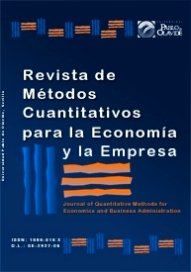Impacto de la inversión en inteligencia artificial en el crecimiento de la economía de Alemania: Un análisis comparativo con Francia entre 2013 y 2022
DOI:
https://doi.org/10.46661/rev.metodoscuant.econ.empresa.10633Palabras clave:
Inteligencia Artificial, Progreso Técnico, Productividad, Crecimiento económicoResumen
En el marco de la revolución tecnológica contemporánea, la inteligencia artificial (IA) toma un papel en la vida cotidiana de los agentes económicos. Alemania y Francia, dos potencias europeas, han experimentado esta transformación recientemente. La IA ha permeado los sectores productivos, impulsando la eficiencia económica y la producción, por lo que se presenta como un catalizador de la innovación y la competitividad, optimizando procesos y generando valor agregado en la economía de estos países. Mediante un enfoque cuantitativo, se analiza la contribución de la IA en la producción y su integración con la misma, para poder entender la posición de Alemania frente a Francia en términos de adopción tecnológica y su impacto en el crecimiento de la economía de Alemania. Los resultados muestran que, como Alemania invierte más en IA que Francia en términos absolutos y relativos, y como la inversión en estas tecnologías por sector económico se adapta a la variación del PIB por industria, el país germano creció un 4% más que Francia entre 2013 y 2022, por lo que se muestra un impacto en el diferencial de crecimiento ocasionado por la inversión en IA.
Descargas
Citas
Abdalá, M. B., Lacroix Eussler, S., & Soubie, S. (2019). La política de la Inteligencia Artificial: sus usos en el sector público y sus implicancias regulatorias. Documento de trabajo, 185. Acemoglu, D. (2024). La Macroeconomía de la IA. NBER. N° 32487
Aldcroft, D. & Morewood, S. (2013). La Economía Europea 1914-2012. Crítica Barcelona.
Banco Mundial. (2022). Datos por país. https://datos.bancomundial.org/
Bernal, B., & Reyes, J. (2010). El residuo de Solow revisado. Revista de economía institucional, 12(23), 347-361.
Brumback, B. A. (2022). Fundamentos de Inferencia Causal con R. Chapman and Hall/CRC.
CAF (2021). Experiencia: Datos e Inteligencia Artificial en el Sector Público
Cunningham, S. (2021). Inferencia Causal. University Press New Haven & London
Deutsche Welle. (2019). Alemania: 500 millones más en la IA.
Fondo Monetario Internacional (FMI). (2023). World Economic Outlook. Abril 2023. FMI. https://www.imf.org/en/Publications/WEO/Issues/2023/04/11/world-economic-outlook-april-2023
Garın, J., Lester, R., & Sims, E. (2018). Intermediate Macroeconomics. This Version 3.0.
Greene, W. H., & Sánchez, J. A. H. (1999). Análisis econométrico (Vol. 3). Madrid: Prentice Hall.
Hernández Sampieri, R., & Baptista, C. (2014). Metodología de la Investigación. México. Editorial Mc Graw Hill.
Huntington-Klein, N. (2022). El Efecto: Una Introducción al Diseño de Investigaciones y Causalidades. Chapman and Hall/CRC.
Kouziokas, G. (2017). La aplicación de la inteligencia artificial en la administración pública para la previsión de áreas de transporte de alto riesgo de delincuencia en el entorno urbano. Procedimiento de investigación de transporte. p. 467-473.
Levin, R. & Rubin, D. (2004). Estadística para Administración y Economía. Pearson educación.
Nicholson, W. (2009). Teoría Microeconómica: Principios Básicos y Ampliaciones. Ediciones Paraninfo, SA.
OCDE AI Policy Observatory. (2022). Trends and Data. OCDE. https://oecd.ai/
Purdy, M. & Daugherty, P. (2016). Inteligencia artificial, el futuro del crecimiento. Accenture Institute for High Performance.
Romer, D. (1997). Macroeconomía Avanzada. Editorial Mc Graw Hill
Romero, L. & Mendoza, M. (2016). Econometría con R. UNAM. Facultad de Estudios Superiores Acatlán.
Solans, A. (2019). Hacia la era de la inteligencia artificial. Edita: Fundación Telefónica Patronato de Fundación Telefónica. p. 114.
Stanford Institute for Human-Centered AI. (2022). AI Index Report 2022. https://aiindex.stanford.edu/ai-index-report-2022/
Stanford Institute for Human-Centered AI. (2023). AI Index Report 2023. https://aiindex.stanford.edu/wp-content/uploads/2023/04/HAI_AI-Index-Report_2023.pdf
Statistisches Bundesamt. (2022). GENESIS DataBase. Statistisches Bundesamt. https://www-genesis.destatis.de/datenbank/online
Tecnológico de Monterrey. (15 de mayo de 2024). Principios éticos de la educación con Inteligencia Artificial (IA). Instituto para el Futuro de la Educación / Observatorio. https://observatorio.tec.mx/edu-news/principios-eticos-de-la-educacion-con-inteligencia-artificial-ia/
UNESCO. (2021). Recomendaciones de Ética para la Inteligencia Artificial.
Weller, J., Gontero, S., & Campbell, S. (2019). Cambio ecnológico y Empleo: Una Perspectiva Latinoamericana. Riesgos de la sustitución tecnológica del trabajo humano y desafíos de la generación de nuevos puestos de trabajo. ONU, CEPAL.
Publicado
Cómo citar
Número
Sección
Licencia
Derechos de autor 2024 Zeus Grafe Pérez

Esta obra está bajo una licencia internacional Creative Commons Atribución-CompartirIgual 4.0.
El envío de un manuscrito a la Revista supone que el trabajo no ha sido publicado anteriormente (excepto en la forma de un abstract o como parte de una tesis), que no está bajo consideración para su publicación en ninguna otra revista o editorial y que, en caso de aceptación, los autores están conforme con la transferencia automática del copyright a la Revista para su publicación y difusión. Los autores retendrán los derechos de autor para usar y compartir su artículo con un uso personal, institucional o con fines docentes; igualmente retiene los derechos de patente, de marca registrada (en caso de que sean aplicables) o derechos morales de autor (incluyendo los datos de investigación).
Los artículos publicados en la Revista están sujetos a la licencia Creative Commons CC-BY-SA de tipo Reconocimiento-CompartirIgual. Se permite el uso comercial de la obra, reconociendo su autoría, y de las posibles obras derivadas, la distribución de las cuales se debe hacer con una licencia igual a la que regula la obra original.
Hasta el volumen 21 se ha estado empleando la versión de licencia CC-BY-SA 3.0 ES y se ha comenzado a usar la versión CC-BY-SA 4.0 desde el volumen 22.










